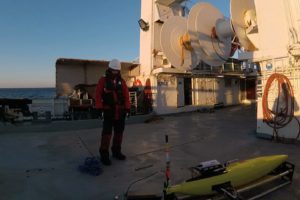Cyprus Subsea team has over ten years of glider operation experience. With more than 20 launches and successful recoveries, our background represents several glider-years and tens of thousands of profiles.
Our collective experience with local and international scientific researchers on marine engineering projects and sea operations makes Cyprus Subsea a unique company in the region and worldwide.




GROOM II
The GROOM II project will define the overall organization of an infrastructure dedicated to ocean research and innovation and maritime services supporting Blue Growth. The project will deliver the decision basis for an advanced Marine Research Infrastructure (MRI) that promotes scientific excellence, fosters innovation, supports the blue economy, builds industrial and public partnerships and works towards helping achieve the common research and innovation mission for future Europe.

TechOceanS
The TechOceanS Project aims to create new technology for underwater vehicles to support ocean conservation and monitoring. The TechOceanS Project’s unique and encompassing approach engages scientists, marine stakeholders and policy makers. Overall, the project advances our collective understanding of essential ocean variables in support of a healthier ocean!

OS Aqua
OS Aqua is a national project that will enable the strategic development of an open sea aquaculture industry in Cyprus. In addition to significantly increasing food production, the project aims to minimize impact to the natural environment. The project defines maritime zones, design facilities, automatization and monitoring systems and conducts a financial sustainability study.

MARI-Sense
In collaboration with a consortium of 12 high-profile partners, the overall goal of MARI-Sense is to design and develop a one-stop Cognitive Decision Support System essential to entities that need to “make sense of the maritime environment” via intelligent collection, interpretation and meaningful presentation of maritime data.

SMART Cable
The SMART Cable is a programmable cable assembly intelligently connecting a marine sensor to a platform. As an innovative cable, the assembly consists of an ultra-low power electronics circuit embedded between each end. The cable assembly allows several functionalities and data processing capacity for input and/or output data.

STEAM
Currently, CSCS contributes to advanced Sea Traffic Management systems. As a work package leader, Cyprus Subsea develops efficient port management tools and innovative monitoring and forecasting systems to reduce the risk and impact of accidents at sea around the Port of Limassol.

Glider Services (Norwegian Sea)
CSCS supported Kongsberg Maritime with Seaglider operations in the Norwegian Sea. A region that is known to be particularly challenging. Visit this page for plotted currents extracted from met.no ocean simulations.

BRIDGES
BRIDGES aimed for the development of new underwater platforms, deep (2400 m) and ultra-deep (5000 m) gliders. Ocean gliders are used commercially in the fields of environmental monitoring, oil and gas and deep sea mining. As a result, the project addressed market needs and advanced several technical achievements to produce these platforms.

Right Whale Study
This study was carried out by Advanced Offshore Operations, a subsidiary of CSCS. For this project, we designed and carried out an underwater glider mission plan along the shelf break in the mid-Atlantic bight. We used a Seaglider (Kongsberg Underwater Technology Inc.) with an integrated passive monitoring system to detect vocalizations of right whales. For more information, please contact Dr. Doug Nowacek at Duke University, the principle investigator of the project.

Coastal Oceanography Studies
This project measured currents, waves and turbidity of a site near Paphos, Cyprus for 6 months. In addition, we measured high accuracy tidal levels in the Port of Paphos. Similar studies have been conducted in the past in other regions of Cyprus. However, these data sets provide calibration and validation with near coastal models for planning and permitting procedures, as well as baseline values of turbidity. We used an Acoustic Doppler Current Profiler with pressure sensor and wave capabilities.

